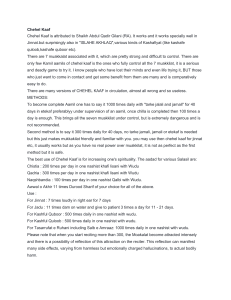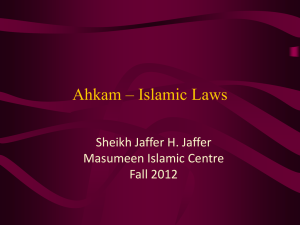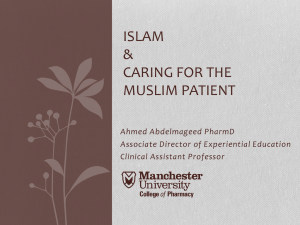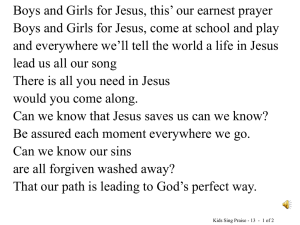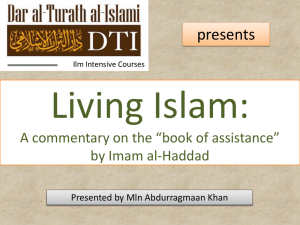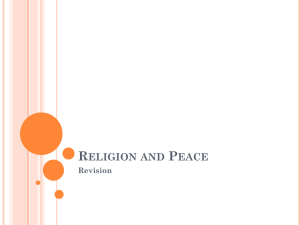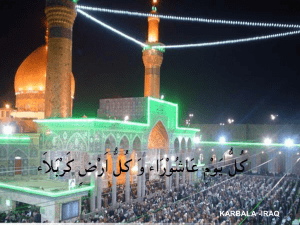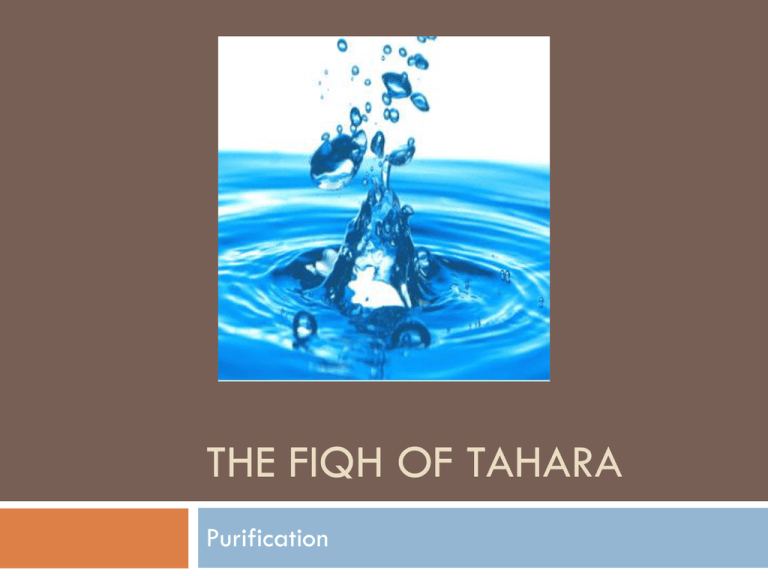
THE FIQH OF TAHARA
Purification
Why Are We Starting With Tahara?
The first part of Fiqh Studies is Salat, but the hukm
al-wad’ee for Salat is Wudu & Ghusl, collectively
known as: Aspects of Taharah—Purification, and so
this is where the discussion on Salat commences; with
Tahara.
The two main categories of Taharah are:
Haqi’qiyah: the main purpose of this type of tahara
is to purify one’s self for worship.
Hukmiyah: here the purpose is to remove a physical
najasa, for example cleaning ones self after visiting
the bathroom.
Haqi’qiyah vs. Hukmiyah
The main difference between these two classes of
tahara is that haqi’qiyah refers to spiritual
cleanliness versus hukmiyah which refers to physical
cleanliness. For example, if a person just took a
shower they are clean in both the haqi’qiyah and
hukmiyah sense. But, if the person passes gas (farts)
then he/she is no longer haqi’qiyah (meaning
he/she can’t pray), but the person is still hukmiyah
(so he/she can still read Quran).
Haqiqiya
In order to be in this state it requires a person to
perform wudu’, or ghusl, or tayummum. While there
are certain things that break ones wudu’ there is
one main problem and that is if any type of Najasa
(filth) that falls on him or her.
What are these Najasa?
Anything that exits the private parts of the
human body:
1.
2.
3.
4.
5.
6.
Urine
Feces
Menses
Madhi’eh (lubricating excretion due to sexual
excitement)
Nifas (Post-natal bleeding)
Post-menstrual bleeding
What are these Najasa?
Flowing blood (a superfluous bleed from a cut, or
a nose bleed)
1.
2.
3.
man, woman, or animals (the ones that are not eaten,
such as swine)—this blood is najasa (filthy)
insects—their blood is tahir
animals that we can eat—we are allowed to touch the
blood, not eat it
What are these Najasa?
Animal Droppings
1.
2.
Birds that fly and that we can eat—the droppings are
tahir. Ex. Pigeon
Birds that don’t fly (chickens—their droppings are
najasa.
Muslims do NOT eat seagulls or crows
What are these Najasa?
Khamr (beer, wine, etc.)
1.
2.
Najis to drink and consume
If in perfume or cologne, or medicinal form (rubbing
alcohol) then it is halal
What are these Najasa?
Al-Mayta (dead carrion that has not been
slaughtered properly, a corpse of a dead squirrel
or bird)
1.
2.
3.
4.
the corpse of something that does not bleed is tahir
(insects)
something that bleeds, but that is halal to eat dead is
tahir (fish)
human—man, woman, child, Muslim, non-Muslim or other
is tahir if it is touched; and all bodies are to be treated
with dignity.
animals that we can eat are tahir. If not, then they are
najis (swine, donkey)
What are these Najasa?
Swine, Dogs
1.
2.
Swine are absolutely najis in every way imaginable; this
means skin, flesh, saliva, or excretions—no, we cannot
even touch them.
The body and hair of dogs are tahir, meaning we can
pet them if we want. However, their saliva, urine, feces
and blood are completely najasa. Thus, if a dog licks
your clothes you have to wash your clothing and if a dog
licks your hands or face then you must perform wudu’ at
least.
Things to Consider…
There is something called the Qaida Principle, which states that: Anything
Najis is haraam, but everything haraam is not necessarily najis
What if we are hunting with dogs? Whatever the dog catches is fine, as
long as the skin of the animal has not been punctured. In this case just say
Bismillah before skinning and eating the animal.
Muslims can kill, on the spot, the following animals: crows, rats and a black
rabid dog because of the diseases they spread.
Also, we can kill the Gecko, because it is the only animal that betrayed
Prophet Ibrahim (as). When he (as) was in the fire the gecko blew on it to
make it hotter.
Hence, all of the above categories and items are the only things that will
remove a person’s Tahir Haqiqiya.
How is Najasa removed?
Quite simply: with Water. This is because Water is
pure in and of itself and it purifies what it is added
to.
How is Najasa removed?
The conditions for what type of water is allowed:
1.
2.
3.
4.
5.
amount makes no difference
it must be known as water (tea would not work)
it has not changed in Colour, Taste or Smell
It can be moving or stagnant
It can be used or unused
How do you know if something has been cleaned?
1.
2.
3.
The item has been washed and it is obvious
because the colour is gone and the smell and taste
have also gone.
If it is on shoes or a woman’s garment it only needs
that place wiped so that no trace of the najasa is
left
What if the item is something that cannot be
washed—a child urinates in bed—pour 2 pitchers
of water, rub the area, use bleach/detergent if
needed, and let it dry.
Sunnan at-Tahara - Fitra
1.
2.
3.
4.
5.
6.
7.
8.
9.
Circumcision for the male—and this is from the times
of Ibrahim (as)
Removing hair from the private regions (termed
istihdad)
Removing the armpit hair
Trimming the nails
Trimming the mustache hair
Using the siwak or toothbrush (before every prayer)
Trimming the beard
Blowing your nose with water
Using small amounts of water (not being excessive)
So What Breaks the actual Wudu’?
1.
Anything that exits the private area: gas, liquid, or
solid: this breaks the minor level of wudu’, meaning
haqiqya. You cannot pray but other forms of
ibadah are okay, like reading Quran.
So What Breaks the actual Wudu’?
2.
3.
4.
5.
Sleep of any kind—fainting included. Not just
dozing off, but when the chin touches the chest and
you are in slumber-mode.
Anything that removes mental faculties—bouts of
insanity, alcohol
Vomiting or bleeding—when excessive.
Eating camel meat
So What Breaks the actual Wudu’?
6.
7.
8.
Ridda—leaving Islam, doing an act of kufr, such
as willfully not praying.
Doing ghusl for a dead person
Touching one’s private parts (skin to skin, for
pleasure—same for touching one’s spouse);
touching without gratification is okay
So What Breaks the actual Wudu’?
9.
Touching the Opposite Sex: There are four main
opinions presented here, with Imam Ahmed being
the Rajih (most correct position)
a)
Imam Shafi’i If there is contact between a man and
a woman with the explicit r implicit intention of
seeking pleasure then the wudu’ is nullified. This
includes any part of the body, whether it is skin to
skin or through clothing.
So What Breaks the actual Wudu’?
b)
I.
II.
III.
Imam Malik: In his madhab Imam Malik mentions
three conditions, all of which must be met to break
the wudu of a person:
The person being touched or doing the touching is
mature
The one doing the touching is seeking pleasure
The person being touched is receiving pleasure
So What Breaks the actual Wudu’?
c)
Imam Ahmed: If one is touching for pleasure then the
wudu’ is broken, otherwise this is fine. The reasoning
here comes from a hadith when the Prophet (saw)
was praying the tahujjud and when going down for
sujood he (saw) picked up and moved the feet of
Aisha (ra).
So What Breaks the actual Wudu’?
d)
Imam Abu Haneefah: Imam Abu Haneefah states that
it could be skin to skin, pleasurable or not—no
matter what, the wudu’ is never broken. Essentially
one could kiss his wife right before the salat and it
would be fine.
How does one perform the Wudu’?
1.
2.
The first and most necessary aspect that ensures
one’s wudu’ is complete is the Niya (intention). This
is considered a fard act.
Next and also extremely important is the
basmala—saying “Bismillah.” This, too, is a fard
act.
How does one perform the Wudu’?
3.
Third, one must wash both hands; this includes the
front, sides and backs of the hands and in
between the fingers. Furthermore, one should rub
the hands to remove any filth. For women, nail
polish must be removed before performing the
wudu’ as nail polish acts as a barrier from the
water cleaning the nails. Mendhi or Henna is
allowed, as it does not act as a barrier. For men
or women, grease and oil needs to be washed off
with soap first, for the same reasons. If soap is not
available, sand will work.
How does one perform the Wudu’?
4.
5.
Then, the face is to be washed three times, with
rubbing to remove any filth. The face includes from
the top of the forehead, to the bottom of the chin and
from one ear to the other ear and in between these
four corners is what is to be cleaned. This is also a
fard aspect of the wudu’.
Fifth, comes the nose and the mouth which are to
cleaned three times each. One should try to do both
simultaneously, but they can be done independently of
each other. For the nose, one must sniffle (not inhale)
some water into the nose to loosen any wastes for
blowing out.
How does one perform the Wudu’?
6.
7.
Next come the arms, which are to be washed three
times each, rubbing to remove any filth. The
“arm” means from the tips of one’s fingers to the
end of the elbow. This is considered a fard action.
The seventh step is to wash the head and hair
once. The hands should be moist and have a little
water in them. The hands are then to pass
backwards over the head and then to the front
again. This is a fard act.
How does one perform the Wudu’?
8.
9.
While washing the head, the ears are also to be
cleaned—inside and outside. One method is to
anchor the index finger on the inner cone while
passing the thumb around the outer cone.
After this come the feet which are to be washed
and cleaned thrice—on top, the bottom and in
between the toes. The area of the foot includes
from the tips of the toes to the top of the ankles.
This is a fard act and must be done.
How does one perform the Wudu’?
10.
11.
For those who have beards—the hands should be
moistened and passed through the beard in a
combing like motion.
If one is wearing a ring or a watch they need to
slide it out of the way to make sure that all parts
of the body are getting wet and cleaned.
How does one perform the Wudu’?
12.
13.
One of the main fard aspects is that all actions
must be completed at the same time. It is not
acceptable for one to wash the hands and face,
go eat dinner and then return to the washroom
and continue with the arms.
Also, another fard aspect is that one must go in
order while performing the wudu’. It is not
acceptable to wash the feet first and then the
hands and then the face.
How does one perform the Wudu’?
14.
15.
While washing the hands, arms and feet the right
side of the body must be washed before the left.
In all stages possible, one should rub the area to
ensure the removal of filth.
How does one perform the Wudu’?
16.
17.
All areas of the body should be washed three
times each, not including the head and that should
only be washed once.
At the end of the ablution, one should recite the
dua’. In this case the dua’ is the shahada: “Ash
hadoo an-la illaha…” The Prophet (saw) taught
us that when a person recites this dua’ Allah opens
the gates for him or her.
How does one perform the Wudu’?
18.
19.
While performing this act of worship one should
try not to be excessive in the amount of water they
use.
If the person has braids in his or her hair—they
must undo the braids before making wudu’.
When is Ghusl needed?
A.
When a person is in a state of sexual
defilement—called Janaba. This includes
sexual discharge of any kind whether in sleep,
or while awake. Janaba also occurs when
there is penetration of the male with the
female, even if only partial penetration.
When is Ghusl needed?
B.
al-Haid, or Menstrual Bleeding. This includes the
following:
1.
2.
3.
Al-‘ada: the regular period—so one should refrain
from praying
Istihada: natural bleeding (reddish blood but without
smell)—one must pray, but must make wudu’ before
salat and purify herself until the bleeding is gone
Post natal bleeding: this is a black, dark and smelly
blood. For this person there is no prayer and no time
constrictions for when this period is finished.
When is Ghusl needed?
For number 1 and 2 however, there is a time limit as
to how long this limit should last and in this case
Imam Malik is has the Rajih:
o Hanafee:
3-15 days
o Shafi’i: 1-15 days
o Ahmed: 1-15 days
o Malik: no time
How does one perform the ghusl?
1.
2.
3.
Use anything that is valid for wudu’.
Niya
Wet all body parts
If necessary a man and his wife can bath
simultaneously (at the same time and in the same
place)
Extra Mustahab actions for Ghusl include:
1.
2.
3.
4.
5.
The wajib and mustahab of wudu’
Washing the feet at the end
Washing the right side first
Rubbing areas where the water doesn’t reach easily,
such as the armpit
For a woman: undoing the braids.
What is tayummum and how is it performed?
Of the 5 things that were given to the Prophet (saw)
and no other prophet before him was that the Earth
has been made a masjid for his ummah—meaning
that we can pray anywhere and that it (the Earth)
can be used to clean and purify a substance.
What is tayummum and how is it performed?
1.
2.
Does Tayammum give full purity from najas? In this
case there are two opinions:
Tayammum is just for that one ibadat (act of
worship) and, so, once that action is complete then
a new tayammum must be made.
Tayammum gives full purity without any limits of
time or actions. This is the RAJIH (the most correct
opinion) as is in the Quran, Sura 5, Verse 6—Earth
is Pure and removes impurities from a person.
What is tayummum and how is it performed?
It should be noted here that this purification is for
the body and not for the clothes. So, if a person
has najasa on their clothes then they have to clean it
so no trace of the najasa is left (again, the Earth
may be used).
What is tayummum and how is it performed?
1.
2.
3.
There are three (3) pre-requisites that must be met
before tayammum can be performed:
There is no water around at all. This entails that
you have searched for the water, but could not
find any.
If there is water, but one is ill and water would
make it worse then they can do tayammum.
There is not enough water to for the whole wudu
What is tayummum and how is it performed?
There are those who claim that Tayammum can only
be performed when the time for salat enters.
However, this is not true because tayammum has no
time limit. The same is found for wudu—that it can
be done at any time.
Tayammum takes care of both Major and Minor
Najasa.
What does one use for tayammum?
Loosely packed dirt, or finely packed granules of
sand, or rocks (basically, the outdoor ground).
There are those who say there has to be dust, but
this is not true as is seen in the example of the
Prophet (saw) when he traveled to Tabook—a
place with nothing but dustless sand.
How does one perform Tayammum?
1.
2.
3.
4.
5.
6.
7.
8.
Niya
Saying Bismillah
Smack the ground with both palms, at the same time
Wipe the hands once over the face
Then the palm of the right hand over the back of the
left hand
Then the palm of the left hand over the back of the
right hand
And then clean off excess dirt off the hand and face,
etc.
Must be done in this specific order
What breaks the Tayammum?
Either (1) you find water (and this means that even
if in the middle of salat water is found, then you
exit the salat and do wudu and redo the salat) &
(2) anything that breaks wudu.

